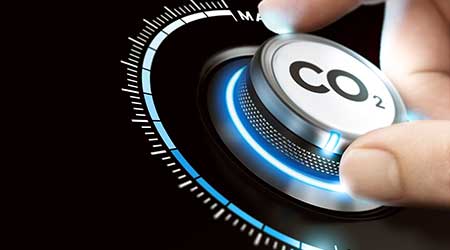Now Is the Time to Get Serious About Carbon Footprint
Because buildings are responsible for 40 percent of carbon emissions, reducing facilities' carbon footprints has taken on the greatest urgency.
By Mahesh Ramanujam, president and CEO, U.S. Green Building Council
When you hear the words “save the planet,” where does your mind go? Is it to images of the Earth from space, panoramas of valleys and mountains, or maybe to a cartoon captain and his team of superheroes? When I was younger, I thought it was about having endless supply of fresh coconut water and banana leaves, and being able to spend my hot summer evenings on the marina beach. The truth is the concept of “saving the planet” is so abstract, so big, that it can mean almost anything to anyone. To address it, we have to shift our language around “saving the planet” to something much more universal, and human: saving each other.
Greta Thunberg, a 16-year-old environmental activist (and Nobel Prize nominee) from Sweden, and a personal hero of mine, recently put the crisis in immediate terms: “The bigger your carbon footprint, the bigger your duty. Adults keep saying we owe it to the young people to give them hope. But I don’t want your hope. I want you to panic and feel the fear I feel everyday. I want you act as if the house is on fire, because it is.”
She hits the nail on the head. How many of us know what a carbon footprint means, let alone what our own personal responsibility is in all this? Recently, the U.S. Green Building Council launched the Living Standard campaign, a storytelling and research initiative designed to understand how diverse communities are thinking about these issues. One young mother in Chicago summed up a pervading sentiment in a few words: “I recycle, I compost, and I don’t throw my garbage in the trash. But the [amount of] garbage I make is tiny versus what Apple or Amazon makes.” And, of course, she’s right.
Our small, everyday actions can seem futile when compared to the environmental damage inflicted by a giant corporation or government entity in a single day.
This commonly held view is a symptom of the fact that saving the planet is just too removed from people’s realities. When we asked who would be impacted from climate change, just 10 percent of our respondents said “people like me” would be impacted.
People are deeply concerned about what changes in the environment will mean for them. But concern and action are two very different things. So we dug deeper, asked a lot more questions, to understand this disconnect. And we found that when something is abstract, it doesn’t just feel distant, it feels daunting. No wonder we’d rather put off dealing with the problem until tomorrow.
But if everyone adopts a defeatist attitude, we’ll be just that: defeated. With the recent UN report warning that we’re headed for environmental catastrophe by 2030 if our behaviors continue, we’ve got to change the ways we live and do business — and fast. We’ve got to act like the house is on fire.
Here’s the good news: There is enormous untapped potential in the green building movement. When asked what terms most strongly relate to being environmentally conscious, only 11 percent of our study participants said green buildings. Yet according to the UNEP Buildings and Climate Report, buildings are responsible for nearly 40 percent of carbon emissions.
Buildings simply aren’t on people’s radar — either as a problem or a solution. This is our opportunity to bridge the gap in understanding. If we want people to believe in the power of green buildings to create a better and more sustainable future, we’ve got to start talking in terms people understand. We need to talk about how a growing carbon footprint will lead to a direct and tangible decrease in our quality of life. We need to emphasize the immediate benefits of sustainable design and operation — things like cleaner air, less exposure to toxins, and safer drinking water.
The year 2030 is only 11 years away. Children born today will have only made it to elementary school before being faced with the terrifying, catastrophic conditions Greta and so many others are warning us about. So the time to act is now.
One of my favorite examples of the power of green buildings is The Center for Civil and Human Rights in Atlanta. A LEED Gold certified building, the 43,335 square-foot space not only keeps with the Center’s mission of creating “a safe space for visitors to explore the fundamental rights of all human beings” — it’s also a testament to American ingenuity and sustainable design. The Center’s new building has innovative features including a green roof, a sophisticated rainwater harvester, and an HVAC system that saves 23 percent more energy that what is typical for similarly sized buildings.
It is, in both concept and design, a building after my own heart. Just like The Center for Civil and Human Rights, Living Standard is all about improving the quality of life for all people, no matter where you live or how much money you make. I firmly believe that a higher standard of living starts with a higher standard of storytelling. To create a better world than the one we inherited, we have to start by asking questions of people who don’t look like us, don’t live where we live, don’t experience everything the same way we do.
When we do that, and when we finally start making decisions that are about taking care of human beings, and about saving each other, we can make buildings like The Center for Civil and Human Rights — beautiful, environmentally conscious, and committed to our shared humanity — the rule and not the exception.
We can put out the fire, but it’s going to take all of us. And the clock is ticking.
Related Topics:












